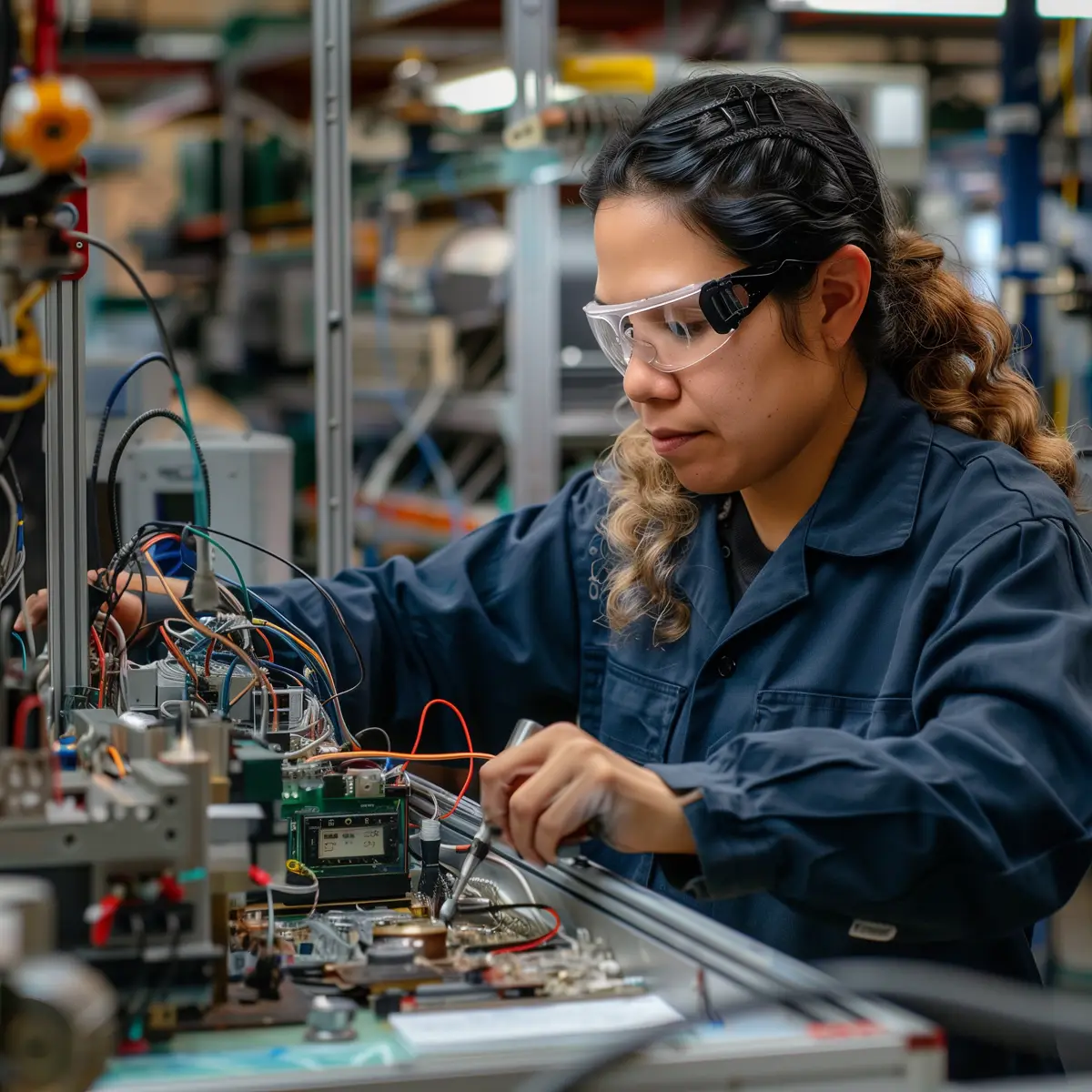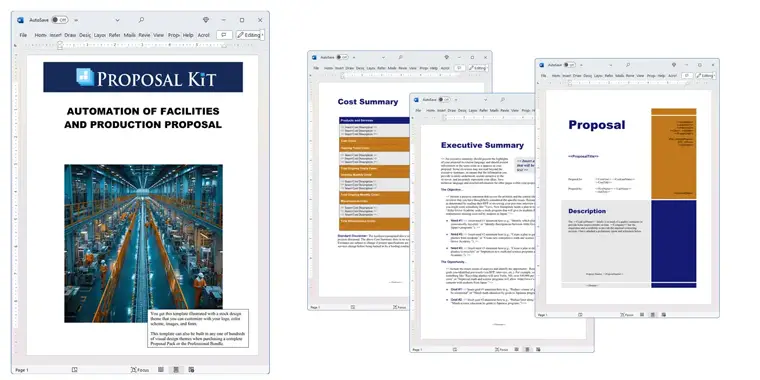How to write your Automation of Facilities and Production Proposal
We include this 18 page layout with every Proposal Pack. If you want this template to have a different visual design theme than the one illustrated here, purchase any Proposal Pack design and create this template using the purchased design theme. This template is included in every Proposal Pack. If you get a Proposal Pack or the Professional, you can also make any variation of this template with different chapters to suit your needs.
We typically include more chapters in the templates than most people will need to give everyone more variety in the chapters they may need. You can trim down a long template by removing pages you do not need or combining multiple chapter topics into one page.
 DOWNLOADABLE, ONE-TIME COST, NO SUBSCRIPTION FEES
DOWNLOADABLE, ONE-TIME COST, NO SUBSCRIPTION FEESYou can also create countless variations of this document to suit your needs using the included library of 2200+ chapters if ordering a Proposal Pack or Professional.
 What Our Clients Say
What Our Clients SayGreat software. Makes writing proposals a breeze. Saved me tons of hours."
Related Article
Related Video
Related Templates
- Equipment or Machinery Systems Upgrade Proposal
- Beverage or Food Manufacturing Project Proposal
- Food Product Development Proposal
- Shifting Production from Commercial to Consumer Proposal
- Product Manufacturing Project Proposal
- Retooling Production Line Proposal
- Product Manufacturing Moving Overseas Proposal
- Industrial Automation Proposal
- Robotics Automation Project Proposal
- Retraining Workers Skills Development Proposal
- Automation Of Manufacturing Processes Proposal Template
- Product Cost Savings Sales Proposal
- Product Manufacturer Proposal
- Food Processing and Storage Services Proposal
- Urban Farming Project Proposal
- New Product Idea Proposal
- Facilities Management Proposal
- Vaccine Production and Distribution Proposal
- Manufacturing Process Improvement Proposal
- Outsource Supply Production Locally Proposal
- Electrical Engineering Project Proposal
- Software Automation Proposal
- Machining Services Proposal
- Electrical System Upgrade Proposal
- IT Operations Finance Banking Proposal Template
- Facilities Management Services Proposal
- Software and Hardware System Proposal
- Process Improvement Proposal
- Industrial Controls System Design and Implementation Proposal
Harnessing the Future: Mastering Automation Proposals with Proposal Kit
The march towards automation in facilities and production is not just a trend but a necessity. Intelligent facilities automation using new technologies will be a key focus for the future. The key to unlocking this transformative journey often lies in a well-written proposal. For many, however, the daunting task of proposal writing, especially in the context of technical automation, can be overwhelming. This is where the Proposal Kit comes in, especially for those new to proposal writing.
Now, imagine you're at the helm of a business decision that involves automating your operations. Can you see yourself navigating this challenge?
Simplifying Proposal Writing with Proposal Kit
For those without any prior experience in proposal writing, the Proposal Kit offers a lifeline. The Proposal Kit template library and Wizard software provides a set of templates, including a line item quoting database system, which is essential for writing comprehensive proposals covering cost summaries, quotes, estimates, budgets, and other financial aspects. A proven approach is to start with the Proposal Kit's template library and Wizard software program, which guide you step-by-step through the process, ensuring that even novices can create professional and convincing proposals.
What Types of Projects Are Automation of Facilites and Production Proposals Written For?
Automation projects can vary widely, but here are some common examples:
- Implementing robotic assembly lines in manufacturing.
- Upgrading to automated inventory tracking systems.
- Installing smart building management systems for energy efficiency.
- Automating quality control processes.
- 3d printing processes driving automation.
- Implementing AI-driven data analysis for operational insights.
- Retrofitting facilities with Internet of Things (IoT) devices.
- Upgrading security with automated surveillance.
- Streamlining internal logistics with robotic solutions.
- Automating environmental control systems in agriculture.
- Developing customer service bots for enhanced customer interaction.
Chapters this template is built with
The Proposal Kit chapter topic library includes thousands of chapter topics to add to your proposal. Key topics from Proposal Kit that can be instrumental in this type of proposal include:
Cover Letter
The cover letter serves as an introduction to your proposal, providing a high-level overview and setting the tone for the document. It should briefly explain the purpose of the proposal, highlight the key benefits of automation, and emphasize your organization's capability and experience in implementing such projects. It should outline the project's main goals, such as improving efficiency, reducing operational costs, and enhancing production quality. This letter should also express enthusiasm and readiness to discuss the proposal in detail.
Executive Summary
The executive summary offers a brief but comprehensive overview of the entire proposal. This section should summarize the automation project's objectives, the plan's key components, anticipated benefits, timeline, and financial impact. It should highlight the critical aspects such as expected productivity improvements, labor cost reduction, and ROI. This summary must be compelling to ensure stakeholders are engaged and motivated to read the proposal.
Modernization
Modernization refers to the updating and upgrading existing facilities and processes to current standards and technologies. This chapter describes how modernizing your facilities and production processes through automation will lead to more efficient operations. Detail the current limitations and how new technologies will overcome these barriers. Include examples of modern equipment and techniques that will be implemented to enhance productivity and ensure the facility meets industry standards.
Expansion Plan
The expansion plan outlines the strategies for scaling operations to meet future demands. Discuss how automation will support the expansion of your production capacity. This might involve adding new automated lines, increasing facility size, or integrating advanced technologies. Explain the rationale behind the expansion, the projected growth in demand, and how the plan will be executed in phases to align with business growth.
Facilities
This section details the physical aspects of the facilities where production takes place. Provide a comprehensive overview of the current facilities, including layout, space utilization, and production capabilities. Explain how automation will transform these facilities, improving workflow, space efficiency, and overall operational effectiveness. Include any required physical structure or infrastructure modifications to accommodate new automated systems.
Equipment
This chapter focuses on the machinery and tools used in production. Detail the existing equipment and its limitations. Then, introduce the new automated equipment to be integrated, highlighting its capabilities, advanced features, and how it will improve production processes. Discuss the benefits of the latest equipment, such as increased precision, speed, and reliability.
Hardware and Software
This section covers the technological backbone of the automation project. Describe the hardware and software systems necessary for implementing automation. This includes control systems, sensors, and management software to drive the automated processes. Explain how these technologies integrate with existing systems, ensuring seamless operation and enhanced data collection for better decision-making.
Workforce
This chapter addresses the human element of the production process. Discuss the impact of automation on the workforce, including changes in roles and responsibilities. Highlight training programs that will be provided to upskill employees, ensuring they can effectively manage and maintain automated systems. Emphasize the potential for job enrichment and creating new roles requiring advanced technical skills.
Operational Impact
This section evaluates the overall effect of automation on day-to-day operations. Analyze how automation will change current operational workflows, increase efficiency, and reduce errors. Compare current and projected performance metrics, such as production output, downtime, and maintenance requirements. Emphasize the strategic benefits, such as enhanced agility and the ability to meet market demands effectively.
Capacity
This chapter assesses the production capacity before and after automation. Outline the current production capacity and detail how automation will increase this capacity. Include specific figures and projections to demonstrate the scale of improvement. Discuss potential bottlenecks and how the proposed automation solutions will address them, ensuring smoother and more scalable production processes.
Installation Schedule
The installation schedule provides a timeline for implementing the automation project. Present a detailed timeline for the installation and integration of automated systems. Break down the project into phases, specifying key milestones and deadlines. Consider minimizing disruption to current operations and outline contingency plans to handle any unexpected delays or issues.
Project Summary
This section provides a recap of the entire proposal. Summarize the proposal's key points, reiterating the automation project's objectives, benefits, and expected outcomes. Highlight the project's strategic importance and how it aligns with the organization's long-term goals. Ensure the summary reinforces the proposal's value proposition and encourages stakeholder support.
Budget
The budget outlines the financial requirements for the automation project. Provide a detailed breakdown of the costs associated with the project, including equipment, installation, training, and ongoing maintenance. Justify each expense, demonstrating how it contributes to the project's overall success. To illustrate cost-effectiveness, include a cost comparison between current operations and the projected automated system.
Cost/Benefit Analysis
This analysis compares the costs of the project with the anticipated benefits. Conduct a thorough cost/benefit analysis, quantifying the expected savings and productivity gains from automation. Highlight tangible benefits, such as reduced labor costs and increased production rates, and intangible benefits, such as improved quality and employee satisfaction. Use this analysis to build a compelling case for the investment in automation.
Return on Investment
The ROI section projects the financial return from the automation investment. Calculate the return on investment, demonstrating the economic viability of the automation project. Use projected figures for increased revenue, cost savings, and efficiency improvements to show how quickly the investment will pay off. Include scenarios for different levels of investment and timelines to provide a comprehensive view of the potential returns. Emphasize how the ROI supports the organization's financial goals and strategic direction.
Use cases for this template
Story of Jasper, the Small Business Owner
Jasper, the proprietor of a small-scale factory automation company, was presented with a pivotal opportunity to bid for a substantial project. This project had the potential to significantly elevate his business's stature in the industry. Jasper, though highly knowledgeable in automation technologies, faced a challenge: his inexperience in writing formal business proposals. Recognizing this, he turned to the Proposal Kit. Jasper started the proposal process with a strategic mindset.
Utilizing the Expansion Plan template, he meticulously outlined how his proposed automation solutions would escalate the client's production capabilities, focusing on scalability and efficiency. He leveraged the Equipment, Hardware, and Software template to comprehensively detail the advanced technological solutions he intended to implement. This included a thorough discussion of the latest in robotics and AI-driven software, emphasizing their transformative impact on the client's operations.
Addressing the financial aspect, Jasper adeptly utilized the line Item quoting database, a feature of the Proposal Kit. This tool enabled him to present a detailed, transparent financial plan, showcasing a robust cost-benefit analysis. This analysis highlighted the long-term financial benefits and efficiency improvements his solutions offered. His proposal, marked by its professionalism and comprehensive nature, was instrumental in securing the project, thereby marking a significant milestone in his business's growth.
Story of Maya, the Corporate Employee
In a large corporation, Maya, known for her meticulous work ethic, was tasked with a challenge: to develop an extensive proposal for automating various facility and production processes within a stringent deadline. Maya recognized the potential of Proposal Kit as a solution to her challenge.
She initiated the proposal with the Modernization template, articulating the necessity for technological upgrades and their potential to revolutionize the company's operations. Utilizing the Operational Impact template, Maya highlighted the anticipated benefits of automation, including enhanced productivity and cost savings, providing a clear vision of the post-automation future.
Maya employed the Proposal Kit's Wizard software to its full potential. This enabled her to quickly assemble a custom proposal and tailor each section of the proposal to precisely match her company's specific needs and objectives. Her effort resulted in a timely, comprehensive, and insightful proposal, which not only met but exceeded her superiors' expectations. Her proposal became a crucial factor in her company's decision-making process regarding the automation project, showcasing the efficiency and effectiveness of Proposal Kit in meeting critical business deadlines.
Story of Liam, the International Volunteer
In his role as a volunteer for an international organization, Liam was tasked with a challenging and socially significant project: to automate a chicken ranch in a developing country. This project required him to write a Request for Proposal (RFP) to attract competent contractors for effective implementation.
Employing Proposal Kit, Liam approached this task with a focus on comprehensiveness and cultural sensitivity. He utilized the Workforce and Facilities templates to ensure that his proposal thoroughly addressed the specific needs and nuances of the project and the local community. He detailed the automation's impact on ranch operations and emphasized the importance of training programs for the local workforce, ensuring long-term sustainability and adaptability.
Despite facing significant cultural and logistical challenges, Liam's proposal, written with the assistance of Proposal Kit, was thorough, culturally attuned, and strategically well-conceived. It successfully attracted a range of competitive bids from suitable contractors. Liam s efforts, greatly facilitated by Proposal Kit, were instrumental in initiating a project that promised not only technological advancement but also substantial socio-economic benefits for the local community.
Conclusions and Recommendations
The experiences of Jasper, Maya, and Liam illustrate the power and versatility of Proposal Kit in writing successful automation proposals. From small businesses to large corporations and international projects, Proposal Kit provides a structured approach to proposal writing. The software's comprehensive template library and financial tools ensure that all aspects of a proposal, from technical details to budget considerations, are professionally presented.
Also Known As
This template may also be referred to in different ways or be used in more specialized situations, such as:
- Facilities and Production Automation Plan
- Automated Production Facilities Proposal
- Industrial Automation Strategy
- Production Process Automation Proposal
- Facility Modernization and Automation Plan
- Smart Manufacturing Implementation Proposal
- Automation Integration Proposal for Production Facilities
- Automated Manufacturing Systems Proposal
- Facility Automation Upgrade Plan
- Intelligent Production Automation Proposal
Abstract
 Automation systems are transforming how facilities and production units operate, making processes faster, safer, and more efficient. This abstract provides a comprehensive understanding of how Proposal Kit helps individuals and organizations create effective business documents, like automation proposals. By using this tool, even those new to proposal writing can define project requirements, outline the scope, and specify details to ensure project success.
Automation systems are transforming how facilities and production units operate, making processes faster, safer, and more efficient. This abstract provides a comprehensive understanding of how Proposal Kit helps individuals and organizations create effective business documents, like automation proposals. By using this tool, even those new to proposal writing can define project requirements, outline the scope, and specify details to ensure project success.
Expertise and a commitment to best practices can lead to future opportunities and other benefits. Companies have used Proposal Kit to align their plans with their clients' needs, overcoming constraints and ensuring safety. By introducing new machines and methodologies from the outset, they ensured smooth operations and satisfied customers.
Automation projects often involve systems integrators who bring together different technologies and machines. Manufacturers and organizations must monitor progress closely, using their knowledge to adapt to any challenges. By preparing clear documents and reports, including manuals and procedures, they can keep everyone informed and maintain alignment with project goals.
 With Proposal Kit, users can create other business documents essential for project success, such as budgets and cost analyses. The tool helps in defining specifications and deliverables, ensuring that all aspects of the project are well-planned. By following these practices, organizations can achieve efficiency and open up future opportunities.
With Proposal Kit, users can create other business documents essential for project success, such as budgets and cost analyses. The tool helps in defining specifications and deliverables, ensuring that all aspects of the project are well-planned. By following these practices, organizations can achieve efficiency and open up future opportunities.
In conclusion, automation systems offer many advantages. With the right tools and knowledge, anyone can plan and execute successful automation projects. Proposal Kit provides the resources needed to create effective proposals and reports, helping to ensure that projects run smoothly from the outset and deliver the expected benefits.
Frequently Asked Questions
What should be included in an automation of facilities and production proposal?
A comprehensive automation proposal should include an introduction, executive summary, modernization plan, expansion plan, facilities overview, equipment details, hardware and software requirements, workforce impact, operational impact assessment, capacity analysis, installation schedule, project summary, budget, cost/benefit analysis, and return on investment. Each section should provide detailed information to support the implementation of automation and its anticipated benefits.
How do I justify the cost of automation to stakeholders?
Perform a detailed cost/benefit analysis that outlines the initial investment, ongoing maintenance costs, and projected savings. Highlight the efficiency gains, reduction in labor costs, increased production capacity, and improved quality. Emphasize the long-term financial benefits and potential return on investment. Provide case studies or examples of similar successful automation projects to reinforce your argument.
How can I ensure a smooth transition to automated systems?
Ensuring a smooth transition to automated systems requires meticulous planning and phased implementation. Conduct a thorough assessment of current processes and infrastructure, identify potential challenges, and develop a detailed migration plan. Engage with all stakeholders early in the process and provide comprehensive training for the workforce. Implement a phased approach to minimize disruptions and perform extensive testing before full-scale deployment to address any issues.
How will automation affect the workforce, and how should it be addressed?
Automation will likely change the roles and responsibilities of the workforce, leading to a shift towards more technical and supervisory positions. Address this impact by developing a robust training and development program to upskill employees, ensuring they are prepared to manage and maintain the new systems. Communicate the benefits of automation to the workforce, such as reduced repetitive tasks and the potential for job enrichment, to foster a positive attitude towards the transition.
How do I assess the operational impact of automation on current processes?
To assess the operational impact of automation, conduct a comprehensive analysis of existing workflows and identify areas where automation can improve efficiency and productivity. Compare current performance metrics with projected outcomes post-automation, such as production speed, error rates, and downtime. Evaluate how automation will integrate with existing systems and processes and identify any potential bottlenecks or challenges that need to be addressed. This assessment will help ensure that the transition to automated systems enhances overall operational effectiveness.
20% Off Discount
![]() Add To Cart This Word Template
Add To Cart This Word Template
 Add To Cart Proposal Pack for Any Business
Add To Cart Proposal Pack for Any Business
 Add To Cart Proposal Kit Professional
Add To Cart Proposal Kit Professional
 4.7 stars, based on 849 reviews
4.7 stars, based on 849 reviewsProposal Kit chapters used in this template
Cover Letter, Title Page, Table of Contents, Executive Summary, Modernization, Expansion Plan, Facilities, Equipment, Hardware and Software, Workforce, Operational Impact, Capacity, Installation Schedule, Project Summary, Budget, Cost/Benefit Analysis, Return on Investment, Back Page
Line Item Automated Chapters
If you purchase a Proposal Pack or the Professional Bundle, these proposal pages are generated using an automated line-item database in the included Wizard software.
Install Schedule, Budget Three Year, Cost Benefit Analysis, ROI Spreadsheet
You use this proposal for
- General business proposal
- Technical proposal
- Project pitch proposal
- Construction, contracting, building proposal
- Manufacturing, engineering, fabrication proposal
- Ranching proposal
How to create this template with Proposal Pack Wizard
You can create this document using any of the logo-designed Proposal Packs. Pick any Proposal Pack with a logo design theme you like best; they will all work equally well. The Proposal Pack for Any Business is the pack with no extra added logos or colors - designed to be used plain or for you to customize with your logos and graphics.
The Proposal Pack design theme you purchase will determine the visual look of this template. The screenshot above only shows the plain generic design theme.
We include a library of chapters to be assembled based on your needs. All proposals are different and have different needs and goals. We designed Proposal Pack so you can customize the documents to suit your needs.
You will best create this document using the Proposal Pack Wizard - Expert Edition software to select this template and build it in the Proposal Pack logo design theme of your choice along with any desired customizations (such as adding additional chapters, removing unneeded chapters, changing the order of chapters, and importing your company logo). This template outlines a proposal for the described situation. Each user is responsible for typing in the actual content of the provided pages with their information to complete the proposal. Suggestions in the abstract may include features in higher-end packages and are facilitated by the selection of chapter templates to support the narrative of each proposal, which help guide the user in filling in the details.
The Wizard software's AI Writer will write the content of the pages of the template based on details provided for your company, client, project, financial details and other writing instructions. This will provide a personalized version of the template completely written and ready to edit.
Once finished, the AI Writer's Word-to-PowerPoint converter can transform your proposal, business plan, or other business documents into a PowerPoint slideshow. Save time and effort by letting the AI analyze every chapter to condense its content into talking points, visually matching the document, and providing a consistent package of presentation material with the click of a button.
You create this template using the Wizard software with an entire Proposal Pack library and software. We include the Expert Edition of the software in the Proposal Kit Professional. Microsoft Word for Windows is required to use the customizing software. You can also edit Word document templates in other office software such as Word for Mac. We will assist Mac users in assembling complex templates for their first project if they do not have the required platform to run the Wizard software.
How to Build Templates Featured on Proposal Kit Website
Many people find the Proposal Kit website after searching for a specific proposal. Once you've purchased and installed the software, how do you build that template you found in the first place? This video shows you how to build any proposal you see on the Proposal Kit website.
 Ian Lauder has been helping businesses write their proposals and contracts for two decades. Ian is the owner and founder of Proposal Kit, one of the original sources of business proposal and contract software products started in 1997.
Ian Lauder has been helping businesses write their proposals and contracts for two decades. Ian is the owner and founder of Proposal Kit, one of the original sources of business proposal and contract software products started in 1997.By Ian Lauder
 Published by Proposal Kit, Inc.
Published by Proposal Kit, Inc.


 Cart
Cart
 Get 20% off ordering today:
Get 20% off ordering today: 


 Facebook
Facebook YouTube
YouTube Bluesky
Bluesky Search Site
Search Site